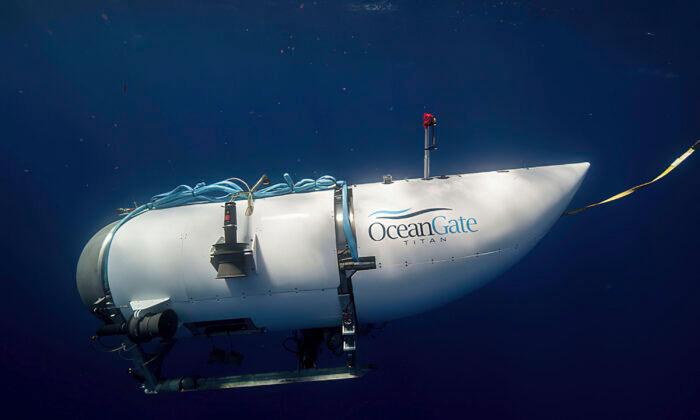The crew of five men aboard a missing submersible vessel on an expedition to explore the Titanic wreckage is projected to exhaust their oxygen supply by 7 a.m. EDT Thursday morning, according to U.S. Coast Guard projections.
The vessel, named Titan and measuring 21 feet in length, vanished in the waters of Newfoundland on Sunday morning during an OceanGate Expeditions mission.
Officials confirmed on Monday that the submersible had a 96-hour supply of “emergency” oxygen. This means that the crew will run out of breathable air by roughly 7 a.m. on Thursday.
“Our previous estimates were based on the approximate oxygen capacity of the vessel at the time of deployment (about 96 hours),” a Coast Guard spokesperson told The Epoch Times via email early Thursday morning. “As our only information was based on that initial 96 hours, any further estimates are too uncertain for us to confirm.”
During a press briefing held earlier on Wednesday, Coast Guard Capt. Jamie Frederick didn’t explicitly disclose the precise time when the oxygen supply is expected to deplete. He said that he would discuss this matter with the crew’s family before providing updates to the public. He noted that the submersible vessel was equipped with limited food and water rations.
Frederick, joined by officials from the Coast Guard, Royal Navy, and an oceanographic research institute, emphasized that the primary focus of the search efforts remains on search and rescue rather than search and recovery.

Search Continued Wednesday
The search for the missing submersible vessel continued on Wednesday, led by a unified command consisting of the U.S. Coast Guard, U.S. Navy, Canadian Coast Guard, and OceanGate Expeditions from the Research Vessel Polar Prince.The submersible, owned by the Canadian Research Vessel Polar Prince, carried a crew of five individuals whose expedition was to explore the wreckage of the Titanic, located approximately 900 nautical miles East of Cape Cod.
“We will continue to work as hard and as quickly as possible in an effort to locate them,” Frederick told reporters on Wednesday.
The search operation, described as highly complex by Frederick, involved covering a surface area twice the size of Connecticut. Underwater search efforts were conducted at a depth of around 2.5 miles.

On Sunday, at 5:40 p.m. EDT, the Coast Guard was informed that the submersible was overdue. It had been launched at 8 a.m. and was scheduled to resurface at 3 p.m. However, contact with the Polar Prince was lost about one hour and 45 minutes into their dive.
On Tuesday, underwater “banging noises” were detected, prompting the deployment of remotely operated vehicles (ROVs) in the designated search areas. Unfortunately, the ROV searches did not yield any results, according to Frederick.
The U.S. Navy is currently analyzing the recorded sounds to guide the search plans and strategies.
Rescue Efforts Face ‘Enormous Complexity’
As the search continues, the rescue experts are facing numerous challenges due to the constantly changing weather conditions, currents, and sea states, which are expanding the search area.“There is an enormous complexity associated with this case due to the location being ... so far off-shore and the coordination between multiple agencies and nations,” Frederick said.
International experts have been lending their support to the search, including from France and the UK. Canadian partners have been providing “critical leadership and significant response capabilities” in the search, according to the U.S. Coast Guard.
On Wednesday morning, the Canadian Coast Guard vessel John Cabot, equipped with sonar technology, joined the search effort. Two commercial Canadian vessels, Skandi Vinland and the Atlantic Merlin, have also joined the search operation.
Furthermore, a crew from the Coast Guard C-130 aircraft has arrived at the scene to continue the ongoing search. Canada’s air force shared a video on Wednesday of one of its CP-140 Aurora aircraft providing surface search and sub-surface acoustic detection capabilities.
The Coast Guard indicated on Wednesday that several additional assets are en route to the location. These include the Canadian Coast Guard Ship (CGS) Ann Harvey and the Canadian Coast Guard Ship (CGS) Terry Fox.
“This is an incredibly complex search operation, requiring both surface and subsurface elements,” said Frederick. “Our unified approach is critical.”
Despite the remoteness of the search zone making it hard to mobilize equipment quickly, the joint search efforts have deployed air, surface, and subsurface assets.
The Motor Vessel Horizon Arctic, equipped with an ROV, was also en route Wednesday, along with the French Research Vessel L'Atalante, which also carries an ROV onboard, the Coast Guard said. His Majesty’s Canadian Ship Glace Bay, transporting a mobile decompression chamber and medical personnel, was also on its way.
Additionally, an Air National Guard C-130 aircraft and an ROV from the vessel Magellan are heading to the location to provide further support.





